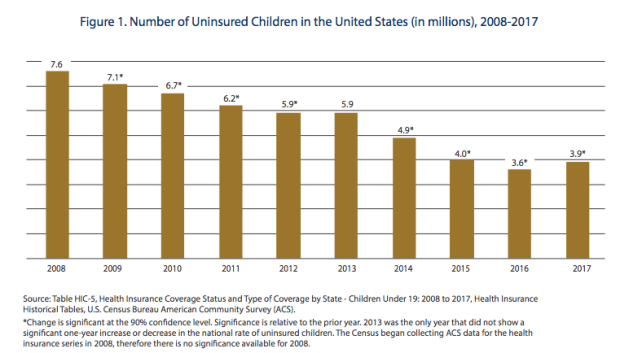The number of uninsured children in Georgia rose by 21,000 last year, mirroring a national increase, according to a new report.
Georgia was one of nine states that had statistically significant increases in their rate of uninsured children, said the report from Georgetown University Center for Children and Families. The uninsured rate in Georgia rose to 7.5 percent of kids, up from 6.7 percent in 2016, the report said.

By contrast, neighboring Alabama’s rate of kids without coverage was 3.1 percent last year.
An estimated 200,000 children in Georgia under the age of 19 do not have health insurance, the report said.
“The general belief is that kids are doing OK,’’ said Erica Fener Sitkoff of Voices for Georgia’s Children. “But it’s getting worse.”
With Brian Kemp becoming governor in a few weeks, she said, “it’s very important for the new administration to understand how serious this is.”

The Georgetown report said the majority of uninsured kids in the nation are already eligible for Medicaid or CHIP (called PeachCare in Georgia) but are not currently enrolled.
Fener Sitkoff called for more streamlined enrollment procedures for establishing eligibility for, and renewal of, kids’ coverage in these government programs. “It’s a very cumbersome process,’’ she said. “Kids are showing up in doctors’ offices, and [parents] realize their coverage has lapsed.”
She cited the findings in a recent Voices report where the advocacy organization conducted focus groups in four geographically diverse counties in the state, asking residents about problems in accessing care for children :
Health insurance coverage improves children’s access to well-child visits, immunizations and prescription drugs, the Georgetown report noted.
Uninsured children are more likely to have unmet health needs and lack a usual source of care. Untreated medical conditions such as asthma lead to missed school days and reduce children’s chances for success in school.
Children living in and near poverty continue to experience the highest uninsured rates.
“With an improving economy and low unemployment rate, the fact our nation is going backwards on children’s health coverage is very troubling,” Joan Alker, the Georgetown center’s director and the report’s lead author, said in a statement. “Barring new and serious efforts to get on track, there is every reason to believe the decline in children’s coverage is likely to continue and may get worse,” Alker added.

For the first time since comparable data was first collected in 2008, the nation’s progress in reducing the number of children without health insurance reversed course, the report said.
The number of uninsured children under age 19 nationwide increased by an estimated 276,000 to about 3.9 million in 2017, according to data from the U.S. Census Bureau. No state experienced a significant decline in the number of uninsured children in 2017 (though the District of Columbia did).
The report also noted an especially troubling trend about states that have not expanded their Medicaid programs — even though expansion is aimed at adults.
Three-quarters of the children who lost coverage between 2016 and 2017 live in states that have not expanded Medicaid coverage to parents and other low-income adults, the report said. The uninsured rates for children increased at almost triple the rate in non-expansion states than in states that have expanded Medicaid.
Alker cited Texas, Florida and Georgia – all of which saw sizable increases in their child uninsured rate.
Children whose parents are insured have considerably higher rates of coverage than those whose parents are not, the report said.
Elected leaders in Georgia, mostly Republicans, have rejected Medicaid expansion as too costly, while Democrats have largely endorsed it. Gov.-elect Kemp is a Republican who has expressed opposition to expansion.

Georgia’s overall uninsured rate, at about 13 percent, is one of the highest in the nation.
The report cited other factors such as the unsuccessful congressional effort to repeal the Affordable Care Act, and the successful repeal of the ACA requirement that people have health insurance. It also pointed to “an unprecedented delay’’ by Congress that allowed CHIP funding to lapse temporarily. In addition, the report noted that the Trump administration cut outreach and enrollment grants and shortened the open enrollment period for coverage.
The report cited estimates that about 1 of every 4 children in the United States has a parent who is an immigrant.
“Several policies targeting immigrant communities are likely deterring parents from enrolling their eligible children in Medicaid or CHIP despite the fact that most of these children are U.S. citizens,’’ the report said.

